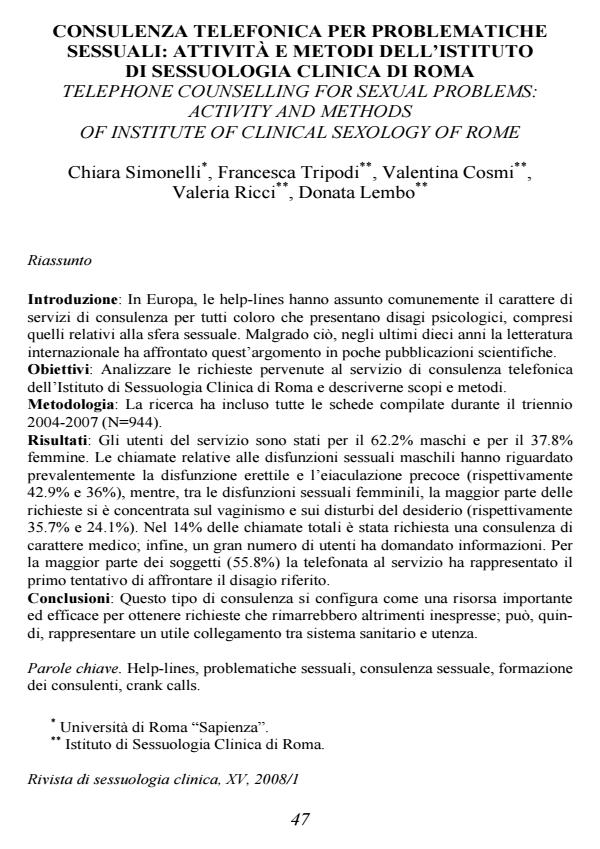Consulenza telefonica per problematiche sessuali: attività e metodi dell'Istituto di sessuologia Clinica di Roma
Titolo Rivista RIVISTA DI SESSUOLOGIA CLINICA
Autori/Curatori Chiara Simonelli, Francesca Tripodi, Valentina Cosmi, Valeria Ricci, Donata Lembo
Anno di pubblicazione 2008 Fascicolo 2008/1
Lingua Italiano Numero pagine 21 P. 47-67 Dimensione file 1067 KB
DOI
Il DOI è il codice a barre della proprietà intellettuale: per saperne di più
clicca qui
Qui sotto puoi vedere in anteprima la prima pagina di questo articolo.
Se questo articolo ti interessa, lo puoi acquistare (e scaricare in formato pdf) seguendo le facili indicazioni per acquistare il download credit. Acquista Download Credits per scaricare questo Articolo in formato PDF

FrancoAngeli è membro della Publishers International Linking Association, Inc (PILA)associazione indipendente e non profit per facilitare (attraverso i servizi tecnologici implementati da CrossRef.org) l’accesso degli studiosi ai contenuti digitali nelle pubblicazioni professionali e scientifiche
Telephone counselling for sexual problems: activity and methods of institute of clinical sexology of rome - Introduction: Help-lines have become a common counselling services in Europe, for men and women who are seeking advice for sexual problems. Despite this, relatively few peer-reviewed reports on this subject have been published in the last decade. Aim: To analyze the requests presented by users calling the help-line of Institute of Clinical Sexology of Rome for sexual problems and to describe the objectives and methods of this counselling service. Methods: The study included all the valid records of the calls received during the 3-year period of 2004-2007 (N=944). Results: The users are the 62.2% males vs 37.8% females. Among the calls about male sexual dysfunctions, the most frequently reported difficulties were erectile dysfunction and premature ejaculation (42.9% and 36% respectively). Among female sexual dysfunctions, the majority of callers reported difficulties such as vaginismus and low/inhibited desire (35.7% and 24.1% respectively). Medical requests were 14% of the total. A large number of calls for information were also received. The majority of callers (55.8%) had not previously sought consultation for their problem. Conclusion: This kind of counselling is an important and effective resource to elicit requests that otherwise might remain hidden and therefore it can be a useful link between the health-care system and callers. Key words: Help-lines, sexual problems, sexual counselling, counsellor training, crank calls.
Chiara Simonelli, Francesca Tripodi, Valentina Cosmi, Valeria Ricci, Donata Lembo, Consulenza telefonica per problematiche sessuali: attività e metodi dell'Istituto di sessuologia Clinica di Roma in "RIVISTA DI SESSUOLOGIA CLINICA" 1/2008, pp 47-67, DOI: